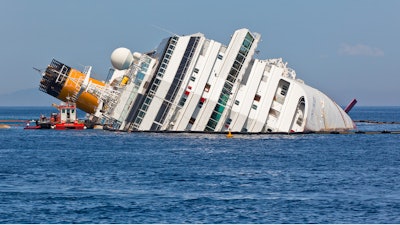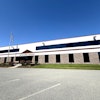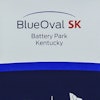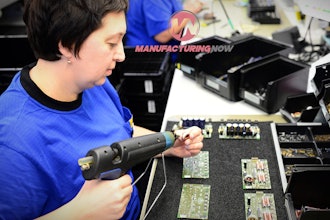
The Flex-Hone tool, characterized by small, abrasive globules that are permanently mounted to flexible filaments, has long been used for everything from automated metal finishing to maintenance and repair operations. Now the Flex-Hone, from Brush Research Mfg. Co., can add one more claim to its resume: playing a small, but important, role in one of the largest engineering feats in marine history—the raising of the shipwrecked Costa Concordia.
The 952-ft long, 17-deck high cruise ship Costa Concordia was wrecked off the coast of Isola del Giglio in Italy on January 13, 2012. It was declared a total loss and 32 people lost their lives. The ship eventually settled on its starboard side in shallow waters with half the boat still submerged.
Concerned about a potential environmental disaster that could result from the large quantity of fuel and oil remaining in the ship's tanks, not to mention a large quantity of rotting food and other health concerns, officials commissioned a salvage effort to move the ship to a suitable port where it could be properly dismantled. Awarded to the American salvaging firm Titan Salvage and Italian underwater construction firm Micoperi, the multi-year effort ultimately cost approximately $2 billion.
Designing a Complex Process
Raising the Costa Concordia sufficiently to move it involved a series of complex steps, several of which had not been attempted in decades. The first step was to secure the hull to land using steel cables to prevent the ship from slipping into deeper water. A horizontal underwater platform was then built just below the ship's position to hold the ship once it was raised.
Hollow, watertight tanks called sponsons were then attached to the ship's exposed port side. When flooded with seawater, the sponsons exerted a downward pull on that side of the ship. With the assistance of winches attached to the platform—a process called parbuckling—the ship was pulled into an upright position on top of the underwater platform.
Once the ship was vertical, water-filled sponsons were attached to the starboard side as well. Then, both sponsons were emptied of water to create the required buoyancy to raise the ship enough so it could be towed to port.
The challenge for Micoperi, a leading offshore contractor that provides subsea solutions for the offshore oil and gas industry worldwide, was to find a way to attach 15 massive steel sponsons to each side of the ship. Combined, the 30 sponsons weighed 11,500 tons.
The plan was to weld the steel sponsons to the hull of the ship, but also to join them together to form "one single, robust, stable body," similar to one integral floating chamber. For this, male and female 'joints' were attached to each container so they could be connected to each other. A tubular frame would then be run through each of these joints to attach all the containers together. Hydraulic pistons within the tubes would pressurize the system to further hold the tanks together as one unit.
A Key Role for the Flex-Hone Tool
Since it was not possible to introduce a single tube more than 100 meters in length, the engineers decided the best solution was to start with a small section of tube approximately 2 meters long and push it through the first male/female joint. Then another section of tube would be welded to the first, which would be pushed through the joints a little further, and another section welded, and so on. This operation would be repeated for the port side, once the ship was raised enough vertically from the initial parbuckling procedure.
To remove the excess material from the welds as they were created—both on the interior and exterior of the tubing—Micoperi required a tool that could remove the excess and would work on an industrial handheld drill. For assistance, Micoperi contacted Vogel, an Italian distributor of machine tools, industrial equipment, and metals. Among its offerings is the Flex-Hone from Los Angeles-based Brush Research Manufacturing.
The Flex-Hone is available in many sizes, 11 abrasive types, and 8 grits. It works well when handheld because the design is automatically self-centering. Using the tool, parts such as carbide bushings, bore sleeves, hydraulic and pneumatic cylinders, and other cylindrical cavities can be surface finished on the production line or resurfaced in the field using a relatively inexpensive tool that requires little setup time.
"Micoperi called us and we discussed whether the Flex-Hone tool could be a solution for its problems," says Sven Pilling of Vogel. "During the discussion, we determined that only the Flex-Hone was suitable. Other tools, like abrasive nylon brushes, would not guarantee enough stock removal."
Micoperi ultimately purchased Brush Research Manufacturing's BC 3 in. SC 60 and BC 3 in. SC 80 Flex-Hone Tools.
The Flex-Hone served another important function by smoothing the way for the hydraulic pistons that were introduced into the tubes.
No stranger to the hydraulics industry, the Flex-Hone tool is already widely used to manufacture all manner of hydraulic cylinders, pumps, jacks, and valves. Hydraulic toolmakers often use the tool to obtain the proper finish in the cylinder bore. If the hydraulic cylinder finish is too rough, U-cups and seals can wear out. If the cylinder surface is too smooth, hydraulic seals may leak.
"In order to allow a smooth movement of the pistons and in order to avoid leakages, the internal tube walls were cleaned and polished successfully with the Flex-Hone," says Pilling.
Although the Costa Concordia project is now complete, the Flex-Hone remains a go-to tool for overhaul and repair for marine applications. The tool is used for cylinder refinishing of big bore (up to 40-in. diameter) diesel main engines of large vessels as well as smaller diesel generators. The tool can also be used for cleaning pipe bores for pipes or other cylindrical bores such as valves on some pump designs.























